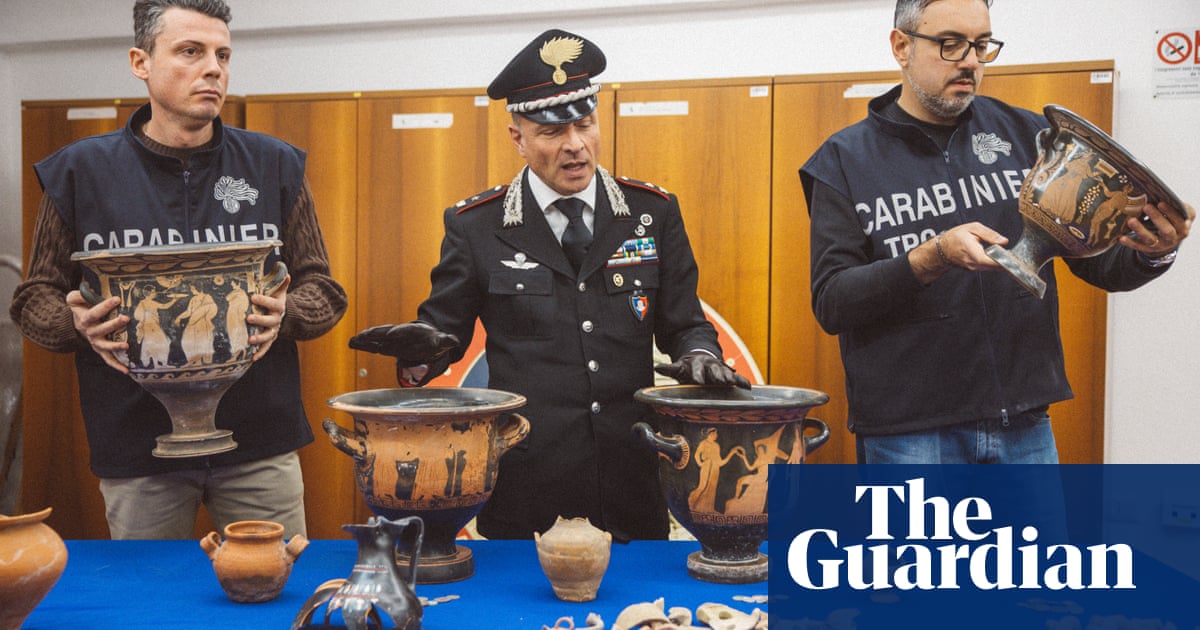Looking towards the semicircular apse with a frescoed image of a partially identifiable Christ on a throne staring back at them, the archaeologists crouching in the small space deep beneath a residential building in Naples were left speechless. They were amid the remains of an 11th-century church.
The archaeologists, however, could not take the credit: the historic jewel, which had just been seized by police, was dug up by tombaroli, or tomb-raiders, illicit gangs who for decades have been plundering Italian cultural sites, in turn fuelling the global market for stolen art and antiquities.
Investigators believe the groupâs leader was a local entrepreneur, currently under investigation, who owns two apartments in the building above. His cellar was turned into a well-organised excavation site, from where the tomb-raiders dug a warren of tunnels leading them about 8 metres down into ancient Naples, where they unearthed medieval art from under the heart of the southern Italian city.
But impressive though their workmanship was â they even installed concrete pillars to prevent the structure from collapsing â officers from the Naples unit of Italyâs Carabinieri cultural heritage protection squad unmasked the gang and confiscated the church after a covert investigation.
The force also recovered 10,000 fragments of Roman and medieval pottery from the alleged gangmastersâ homes and 453 intact artefacts, including vases, terracotta lamps and coins. Experts are assessing whether the relics came from the church or other plundered sites.
So-called tomb-raiders are a key part of the illicit trade in antiquities, with their loot usually smuggled overseas to traffickers. The gangs commonly work by marking out clandestine excavation spots close to known archaeological sites, which in the Campania region surrounding Naples can include Pompeii, Herculaneum, Paestum or areas where there were Roman settlements.
So uncovering a clandestine dig in the middle of the city took the specialist squad by surprise.
âWhen you think of Pompeii, for example, you know a dig can lead to a wealthy domus where prestigious objects can be found,â says Massimo Esposito, the chief of the squadâs unit in Naples. âBut itâs rare to find one in the heart of Naples.â
The groupâs alleged leader is believed to have had an inkling that there might be something beneath his home when construction works nearby on the cityâs metro were interrupted and the site cordoned off after a small part of the remains of another, albeit less historically interesting, church emerged.
The group worked for several months, carrying out their noisiest activity during the day, but not loud enough to attract complaints from the buildingâs residents. Little did the gang know that their comings and goings were being observed by Espositoâs team, with the squad staking out the building and wiretapping its alleged leaderâs phone. Suspicions were especially aroused after seeing him carrying boxes filled with materials.
âKeeping an ear to the ground is essential,â says Esposito. âWe were informed about anomalous construction activity, and intuited that it could be an illegal excavation after records showed there were no public or private works happening in or near that building to justify such activity.â
It is not yet clear if the intention was to sell the loot or amass a private collection.
The Carabinieriâs cultural heritage protection squad was established in 1969 with the task of protecting Italyâs priceless cultural assets. Since then, more than 3m stolen artworks and relics have been retrieved, including those that ended up on display in some of the worldâs biggest museums, such as the Getty in Los Angeles.
Art and relics thieves in Campania especially thrived in the 1980s, taking advantage of a devastating earthquake at the beginning of that decade to ransack churches of paintings. The long-lost La Desposizione, a 2-metre high masterpiece painted by Angelo Solimena in 1664 depicting the crucifixion, was recently returned to Campania only after it was spotted on display in a museum in the Marche region.
Esposito met the Guardian in his unitâs office located in Castel SantâElmo, a medieval fortress overlooking Naples.
He was surrounded by relics recuperated by the force in Campania, including a wine amphora and a house-shaped sarcophagus, believed to have contained the remains of a child, and various other funerary objects dating back to the fourth century AD. The artefacts are usually kept there pending the conclusion of judicial cases, before being either returned to their origin or entrusted to museums.
The tomb-raiders still ply a decent trade, but with the police consistently on their tail, their loot is not as fruitful as it used to be. Data in recent years indicates a gradual decrease in crimes against cultural heritage. Laws for crimes against cultural heritage have been tightened, and work intensified to return stolen assets from abroad. The unit has a database listing more than 1.3m stolen assets, which can be consulted by police forces overseas.
Use of social media, especially over the past decade, has also made it easier for the squad to identify thieves. A trove of funerary treasures, believed to have belonged to Etruscan princesses and illegally excavated from an underground tomb in Umbria, was retrieved in November after police came across a photo of the bungling thieves posing on Facebook as they attempted to sell it online.
âDespite the risk, there is sometimes this egotistical element: they want to boast about the beautiful items theyâve found,â says Esposito.
As with other returned relics, the long-term plan for the medieval church in Naples is to make it accessible to the public.
âThis is always the ultimate goal,â says Esposito. âItaly is an open-air museum, so rich in cultural heritage. This makes our job very arduous, but we are also driven by a passion to ensure that Italyâs property is returned.â

